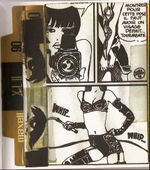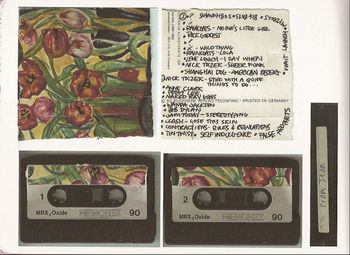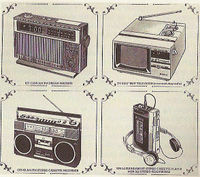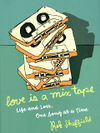Difference between revisions of "Mix tape"
(→Mix Tape Technique) |
(→The User Art form) |
||
| Line 60: | Line 60: | ||
=== The User Art form === | === The User Art form === | ||
| + | |||
| + | '' Predigested cultural artifacts combiend with homespun technology and magic markers turn the mix ttape to a message in a bottle. I am no mere consumer of pop culture, it says, but also a producer of it. Mix tapes mark the moment of consumer culture in which listeners attained control over what they heard, in what order and at what cost ''. | ||
=== Romance, Friendship and Gift Culture === | === Romance, Friendship and Gift Culture === | ||
Revision as of 22:15, 9 November 2010
Sometimes I go to yard sales to buy cassettes compiled by people who are complete strangers to me. You see something that has 'Marty's Mix' scrawled on it in ballpoint pen. You take it home and you don't know if it's going to be US post-punk hardcore or Kenny Rogers. Whatever it is, though, I know I'm getting a slice of someone's life. Cassettes are the only format that can give you that.
- Thurston Moore of band Sonic Youth (Quoted by Pete Paphides)
A Mix Tape is an amateur-created audio cassette music compilation, compiled of different songs from different albums (usually taken from other tapes, from LPs or the radio). While sometimes mix tapes contained songs from various albums by the same artist, most mix tapes were also collections of songs by different artists. Most mix tapes were inherently personal, either kept for oneself, or given to a friend or lover. However, as we shall discuss, mix tapes had special meaning in hip hop culture, in which they were inherently public media forms.
Beginning in the late 1960s, with the emergence of the Philips compact cassette in 1963 and the development of Japanese-made cassette players and recorders in the mid to late 1960s, mix tapers began to challenge the notion of the single-artist album by taking on the role of the creator (Millard 315-6). As scholar Rob Drew notes, “Rather than conforming to artistic intention and industry practice, mixers treated the album as an open work and took the selection and ordering of songs into their own hands” (535). The mix tape thereby enabled people “to make their own personal soundtracks and compilations.“ (535)
As we shall see, the mix tape as it is defined here would disappear in the mid to late 1990s with the emergence of the compact disk, and later the digital playlist. While these musical forms have inherited tropes of the original mix tape form, there are fundamental differences between the experience of creating, listening to, and receiving an original cassette mix tape versus these new "versions".
Contents
Technological History
The Compact Cassette
Following in the tradition of its predecessors, the reel-to-reel, the compact cassette was a device introduced primarily for the purpose of personal and workplace related recording (316). As is indicated by its name, the compact cassette was revolutionary due to its transportable size: small enough to fit into a pocket, and yet able to hold up to 45 minutes of content on each side.
Introduced by Philips in 1963, the compact cassette sold poorly in it's first year, selling only about 9,000 units. As a result, Philips did not declare the cassette as proprietary technology, and instead, encouraged other companies to license the use of the technology. All that Philips required was that all other manufacturers adhere to the Philips standard, so that all manufactured cassettes were equally compatible (317).
As a result of this opening up, by the mid 1960s, a variety of cassette playing devices were being manufactured by various Japanese corporations, notably Panasonic and Norelco. Norelco introduced the first cassette player/recorder, "The Norelco Carry-Corder", powered by flashlight batteries and weighing approximately 3 pounds. By 1968, approximately eighty five different manufacturers had sold over 2.4 million cassette players and recording devices across the globe. Moving in the 1970s, Millard notes, "The Philips compact cassette became the standard format for tape recording by the end of the decade" (317).
The only thing holding the compact cassette back, however, was its sound quality. Unlike the LP record, it was a low fidelity medium with poor sound quality, disturbed by loud tape hissing. Over the years, various companies developed different methods of improving the sound quality. Ray Dolby, an employee of the Ampex Corporation managed to devise improved methods for reducing the noise of magnetic tape. The Dolby A system worked by emphasizing certain high frequencies during the recording process, and then de-emphasizing these frequencies during playback, resulting in less tape "hiss" (318). Manufacturers of magnetic tape, particularly Japanese companies like Sony, Denon and TDK, developed new magnetic materials to coat the plastic tape, thereby accommodating more magnetic information (318). Consequently, the reduction of tape hiss as a result of Dolby's system, combined with "the higher-frequency response of chrome and metal particle tapes" brought the tape into the high fidelity realm, and gained in the respect of audiophiles (319).
As a result of these improved technologies, record companies began releasing albums on compact cassette. Cassettes could be easily and attractively packaged, they were small and durable, while exceeding the playing time of a long playing record. By the late 1970s, the cassette tape had begun to challenge the disc in total sales, and by the early 1980s, the ratio of vinyl to cassette was around 6:4 (320).
Mix Tape Recording Technology
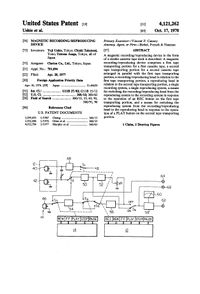
Following the emergence of the cassette tape and early cassette recorders and players was the introduction of more sophisticated home cassette recording technologies by Japanese manufacturers in the 1970s, specifically those that allowed cross media recording.
By the 1970s, the affordable combination record player/radio systems came with a built in cassette player, which could record any output out of the unit, either off the radio, or off a record (319). Simultaneously, the cassette was becoming a more and more popular way to purchase commercial music. Music listeners wanted a way to record music not just from vinyl to cassette, but from audio cassette to audio cassette. This was altered with the emergence of the double or dual cassette deck (see Patent) allowing the user to record from one pre-recorded tape to a blank one in the same unit. This technology would later be developed into the popular, portable "boom box" form, which allowed your tape-to-tape reproduction studio to be taken with you at all times (Millard 322).
By 1982, more than twenty million audio recording devices were believed to be imported into the United States, and it was estimated that approximately sixty percent of American households had at least one tape recorder (Jeffords PAGE). Almost everyone had become a home tapper, and the listener's relationship with music was experiencing fundamental changes.
"Home Taping is Killing Music"
Before there was music downloading and Napster, there were cassette mix tapes. While tape was certainly not the first home recording technology (Edison's wax cylinder phonograph was recordable), it was certainly the first reliable and mainstream one (Walker).
By the 80s, when cassette ripping was becoming increasingly popular, record labels began to fight back, accusing home tapers of killing the music industry (rhetoric which sounds familiar in the post-digitization era). Beginning in 1982, the recording industry began to lobby for surcharges on blank tapes, and even experimented with anticopying technology which would be encoded on vinyl LPs (Walker).
The cassette and cassette equipment manufacturers retaliated with a strong counter lobbying movement, however, and with Sony at the lead (who was simultaneously fighting the Hollywood studios over it's Betamax player), the counter lobbyists won, upholding "a consumer's right to copy for personal use" (Walker).
Home taping was never "killing music", as the record companies claimed it was. People continued to purchase music despite the new cassette recorders, in fact, prerecorded cassettes and discs sold in increasing quantities (Millard 327) It was the way they interacted with that music, as we shall see, that fundamentally changed.
Types
Personal
DJ and Hip Hop Mix Tape
Mix Tape Theory
The User Art form
Predigested cultural artifacts combiend with homespun technology and magic markers turn the mix ttape to a message in a bottle. I am no mere consumer of pop culture, it says, but also a producer of it. Mix tapes mark the moment of consumer culture in which listeners attained control over what they heard, in what order and at what cost .
Romance, Friendship and Gift Culture
Mixtape as Memory
Death of the Mix tape
Contemporary Incarnations
References
Jansen, Bas. "Tape Cassettes and Former Selves: How Mix Tapes Mediate Memories". Sound Souvenirs. Ed. K. Bijsterveld & J. Dijck. Amsterdam University Press
Paphides, Pete. "Thinking inside the (plastic) box: Still cherished by mix-tape romantics, the cassette isn't ready to die, says Pete Paphides". The Times. London (UK): Dec 18, 2009. p. 8
Millard, Andrew. America On Record: A history of recorded sound. Second Edition. New York: Cambridge University Press,2005.
Moore, Thurston. Mix Tape: The Art of Cassette Culture. New York: Rizzoli International, 2004.
Drew, Rob. "Mixed Blessings: The Commercial Mix and the Future of Music Aggregation". Popular Music and Society; Oct 2005; 28, 4; Research Library pg. 533
Walker, Rob. "Hit Rewind". The New York Times 25 April 2010
